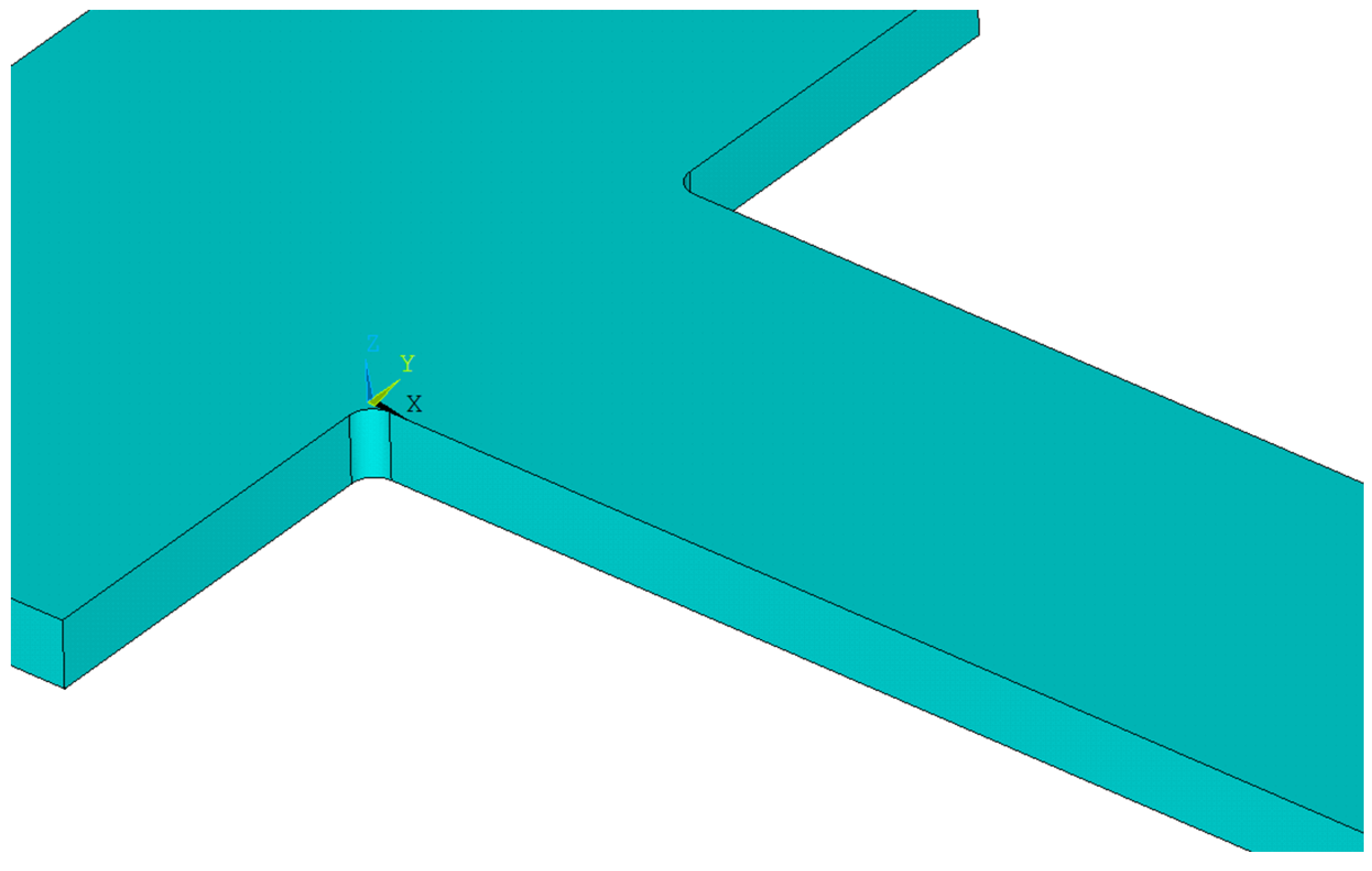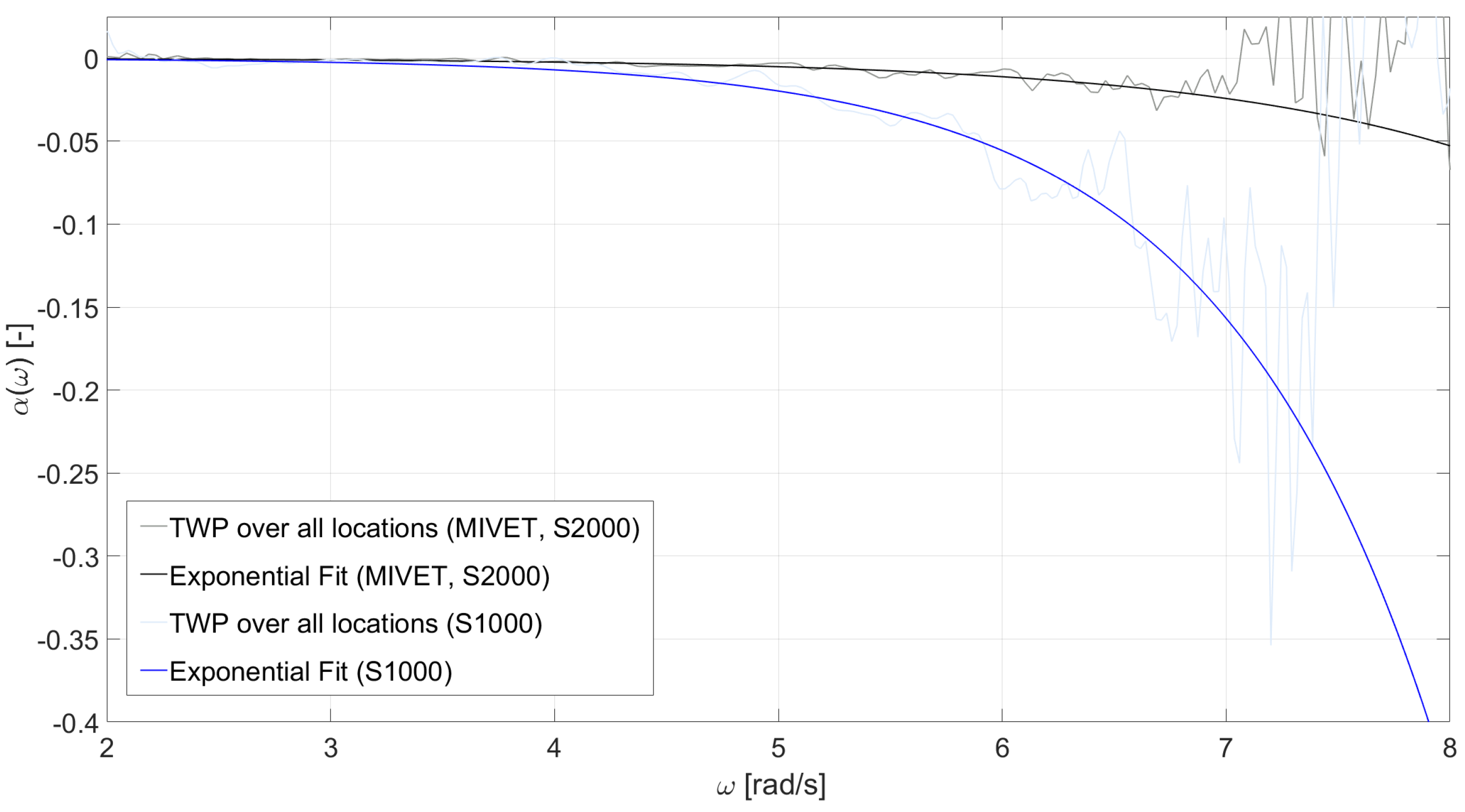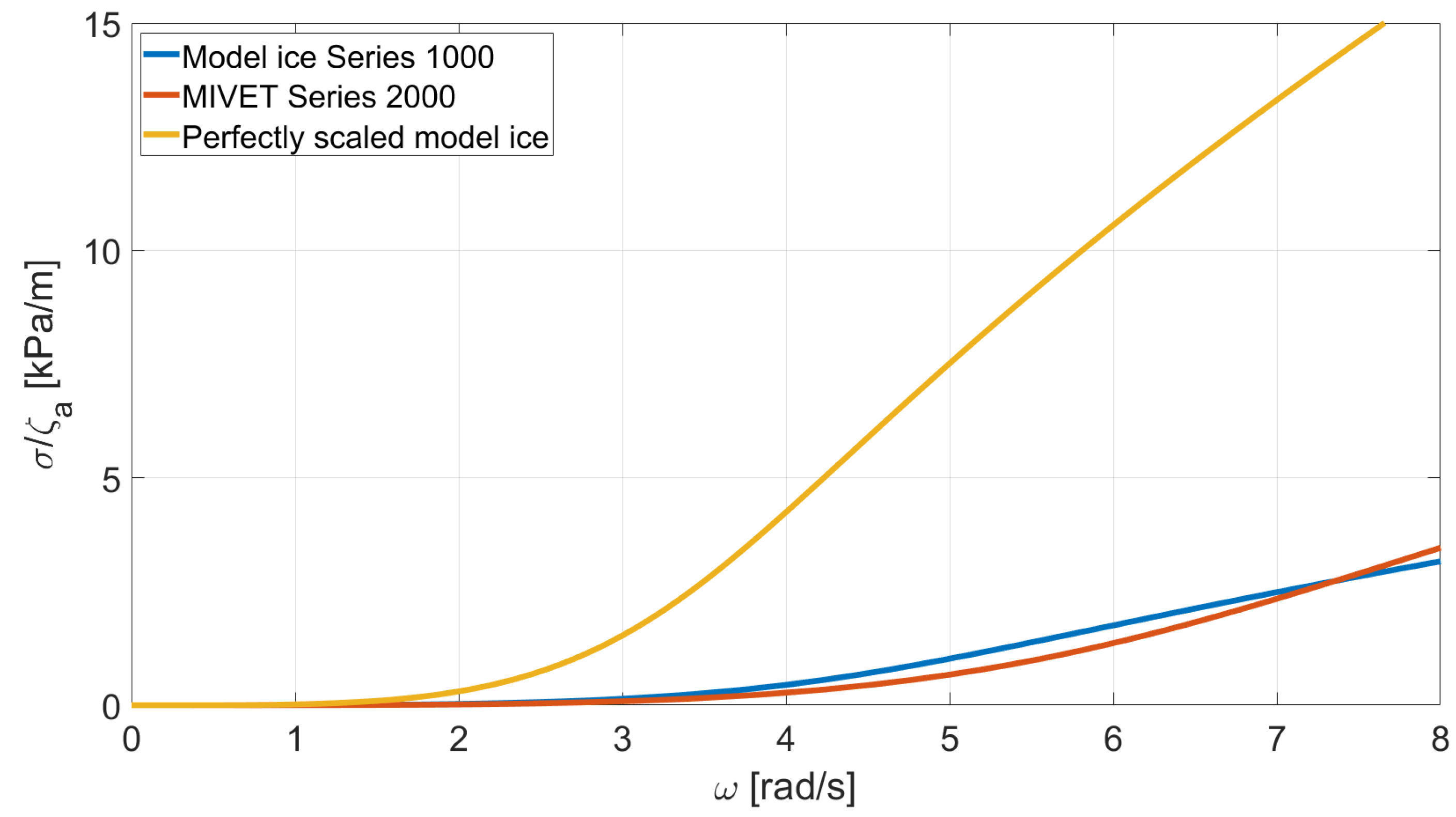A New Model Ice for Wave-Ice Interaction
Abstract
:1. Introduction
2. The Governing Parameters in Wave-Ice Interaction
2.1. Critical Stresses Induced by Waves
2.2. Scaling
2.3. Additional Scaling and Virtual Thickness
3. Experiments
3.1. Model Ice Production and Properties
3.2. Set-Up of Wave-Ice Interaction Experiments
3.3. Experimental Program and Generated Waves
3.4. Experimental Results
4. Analysis and Discussion
5. Conclusions
6. Patents
Author Contributions
Funding
Institutional Review Board Statement
Informed Consent Statement
Data Availability Statement
Conflicts of Interest
Appendix A. Transfer Function for Wave Induced Stresses
Appendix B
| Ultralab USS 30250 | Ultralab USS 2001300 | |
|---|---|---|
| Blind area | ||
| Working range | ||
| Techn. resolution | ||
| Reproducibility |
References
- Prinsenberg, S.J.; Peterson, I.K. Observing regional-scale pack-ice decay processes with helicopter-borne sensors and moored upward-looking sonars. Ann. Glaciol. 2011, 52, 35–42. [Google Scholar] [CrossRef] [Green Version]
- Ardhuin, F.; Otero, M.; Merrifield, S.; Grouazel, A.; Terrill, E. Ice Breakup Controls Dissipation of Wind Waves Across Southern Ocean Sea Ice. Geophys. Res. Lett. 2020, 47. [Google Scholar] [CrossRef]
- von Bock und Polach, R.U.F.; Klein, M.; Kubiczek, J.; Kellner, L.; Braun, M.; Herrnring, H. State of the Art and Knowledge Gaps on Modelling Structures in Cold Regions. In Polar and Arctic Sciences and Technology; American Society of Mechanical Engineers: New York, NY, USA, 2019; Volume 8. [Google Scholar] [CrossRef]
- Manson, G.K.; Davidson-Arnott, R.G.D.; Ollerhead, J. Attenuation of Wave Energy by Nearshore Sea Ice: Prince Edward Island, Canada. J. Coast. Res. 2015, 32, 253–263. [Google Scholar] [CrossRef]
- Hartmann, M.C.N.; von Bock und Polach, F.; Ehlers, S.; Hoffmann, N.; Onorato, M.; Klein, M. Investigation of Nonlinear Wave–Ice Interaction Using Parameter Study and Numerical Simulation. J. Offshore Mech. Arct. Eng. 2020, 142. [Google Scholar] [CrossRef]
- Squire, V. Of ocean waves and sea-ice revisited. Cold Reg. Sci. Technol. 2007, 49, 110–133. [Google Scholar] [CrossRef]
- Zhao, X.; Shen, H.H.; Cheng, S. Modeling ocean wave propagation under sea ice covers. Acta Mech. Sin. 2015, 31, 1–15. [Google Scholar] [CrossRef]
- Sree, D.K.K.; Law, A.W.K.; Shen, H.H. An experimental study on gravity waves through a floating viscoelastic cover. Cold Reg. Sci. Technol. 2018, 155, 289–299. [Google Scholar] [CrossRef]
- Fox, C. A Scaling Law for the Flexural Motion of Floating Ice. In IUTAM Symposium on Scaling Laws in Ice Mechanics and Ice Dynamics; Springer: Amsterdam, The Netherlands, 2001; pp. 135–148. [Google Scholar] [CrossRef]
- Liu, A.K.; Mollo-Christensen, E. Wave Propagation in a Solid Ice Pack. J. Phys. Oceanogr. 1988, 18, 1702–1712. [Google Scholar] [CrossRef]
- Kohout, A.L.; Meylan, M.H. An elastic plate model for wave attenuation and ice floe breaking in the marginal ice zone. J. Geophys. Res. Ocean. 2008, 113. [Google Scholar] [CrossRef]
- Broström, G.; Christensen, K. Waves in Sea Ice; Technical Report; Niels Henrik Abelsvei: Oslo, Norway, 2008. [Google Scholar]
- Wadhams, P. Attenuation of swell by sea ice. J. Geophys. Res. (1896–1977) 1973, 78, 3552–3563. [Google Scholar] [CrossRef]
- Alpers, W.; Hühnerfuss, H. The damping of ocean waves by surface films: A new look at an old problem. J. Geophys. Res. 1989, 94, 6251. [Google Scholar] [CrossRef]
- Wang, R.; Shen, H.H. Gravity waves propagating into an ice-covered ocean: A viscoelastic model. J. Geophys. Res. Ocean. 2010, 115. [Google Scholar] [CrossRef]
- Dolatshah, A.; Nelli, F.; Alberello, A.; Bruneau, L.; Bennetts, L.G.; Meylan, M.H.; Monty, J.P.; Toffoli, A. Wave Attenuation due to Ice Cover: An Experimental Model in a Wave-Ice Flume. In Polar and Arctic Sciences and Technology Petroleum Technology; American Society of Mechanical Engineers: New York, NY, USA, 2017; Volume 8. [Google Scholar] [CrossRef]
- Schwarz, J. New developments in modeling ice problems. In Proceedings of the 4th International Conference on Port and Ocean Engineering Under Arctic Conditions, POAC 77, Conference on Port and Ocean Engineering under Arctic Conditions (POAC), St. John’s, NL, Canada, 26–30 September 1977; pp. 45–61. [Google Scholar]
- Jalonen, R.; Ilves, L. Experience with a Chemically-Doped Fine-Grained Model Ice. In Proceedings of the International Association for Hydro-Environment Engineering and Research (IAHR) Ice Symposium, Espoo, Finland, 20–23 August 1990; Volume 2, pp. 639–651. [Google Scholar]
- Evers, K.U.; Jochmann, P. An Advanced Technique to Improve the Mechanical Properties of Model Ice Developed at the HSVA Ice Tank. In Proceedings of the POAC93, Hamburg, Germany, 17–20 August 1993. [Google Scholar]
- Vance, G.P. A Scaling System for Vessels Modelled in Ice. In Proceedings of the Ice Tech 75, SNAME-Ice Symposium. The Society of Naval Architects and Marine Engineers (SNAME) Ice Tech Symposium, Montreal, QC, Canada, 9–11 April 1975. [Google Scholar]
- Zufelt, J.E.; Ettema, R. Model Ice Properties. In Technical Report CRREL Report 96-1; U.S. Army Corps of Engineers, Cold Regions Research and Engineering Laboratory (CRREL): Hanover, NH, USA, 1996. [Google Scholar]
- Timco, G.; Weeks, W. A review of the engineering properties of sea ice. Cold Reg. Sci. Technol. 2010, 60, 107–129. [Google Scholar] [CrossRef]
- von Bock und Polach, R.; Ehlers, S. Model scale ice—Part B: Numerical model. Cold Reg. Sci. Technol. 2013, 94, 53–60. [Google Scholar] [CrossRef]
- von Bock und Polach, R. Numerical analysis of the bending strength of model-scale ice. Cold Reg. Sci. Technol. 2015, 118, 91–104. [Google Scholar] [CrossRef]
- von Bock Und Polach, R.F.; Ehlers, S. On the scalability of model- scale ice experiments. J. Offshore Mech. Arct. Eng. 2015, 137, 051502. [Google Scholar] [CrossRef] [Green Version]
- Von Bock Und Polach, R.; Molyneux, D. Model ice: A review of its capacity and identification of knowledge gaps. In Proceedings of the International Conference on Offshore Mechanics and Arctic Engineering—OMAE, Trondheim, Norway, 25–30 June 2017; Volume 8. [Google Scholar] [CrossRef]
- von Bock und Polach, R.U.F.; Gralher, S.; Ettema, R.; Kellner, L.; Stender, M. The non-linear behavior of aqueous model ice in downward flexure. Cold Reg. Sci. Technol. 2019. [Google Scholar] [CrossRef] [Green Version]
- Voermans, J.J.; Rabault, J.; Filchuk, K.; Ryzhov, I.; Heil, P.; Marchenko, A.; Collins, C.O., III; Dabboor, M.; Sutherland, G.; Babanin, A.V. Experimental evidence for a universal threshold characterizing wave-induced sea ice break-up. Cryosphere 2020, 14, 4265–4278. [Google Scholar] [CrossRef]
- von Bock und Polach, R.U.F.; Ziemer, G.; Klein, M.; Hartmann, M.C.N.; Toffoli, A.; Monty, J. Case Based Scaling: Recent Developments in Ice Model Testing Technology. In Polar and Arctic Sciences and Technology; American Society of Mechanical Engineers: New York, NY, USA, 2020; Volume 7. [Google Scholar] [CrossRef]
- Passerotti, G.; Alberello, A.; Dolatshah, A.; Bennetts, L.; Puolakka, O.; von Bock und Polach, F.; Klein, M.; Hartmann, M.; Monbaliu, J.; Toffoli, A. Wave Propagation in Continuous Sea Ice: An Experimental Perspective. In Polar and Arctic Sciences and Technology; American Society of Mechanical Engineers: New York, NY, USA, 2020; Volume 7. [Google Scholar] [CrossRef]
- Collins, C.O.; Rogers, W.E.; Lund, B. An investigation into the dispersion of ocean surface waves in sea ice. Ocean Dyn. 2016, 67, 263–280. [Google Scholar] [CrossRef]
- Meylan, M.H.; Bennetts, L.G.; Mosig, J.E.M.; Rogers, W.E.; Doble, M.J.; Peter, M.A. Dispersion Relations, Power Laws, and Energy Loss for Waves in the Marginal Ice Zone. J. Geophys. Res. Ocean. 2018, 123, 3322–3335. [Google Scholar] [CrossRef]
- Dumont, D.; Kohout, A.; Bertino, L. A wave-based model for the marginal ice zone including a floe breaking parameterization. J. Geophys. Res. 2011, 116. [Google Scholar] [CrossRef] [Green Version]
- Palmer, A.C. Dimensional Analysis and Intelligent Experimentation; World Scientific: Singapore, 2008. [Google Scholar] [CrossRef] [Green Version]
- Feng, L.; Qianjin, Y.; Shkhinek, K.; Kärnä, T. A qualitative analysis of breaking length of sheet ice against conical structures. In Proceedings of the 17th POAC Ice Symposium, Busan, Korea, 16–19 June 2003. [Google Scholar]
- Newman, J.N. Marine Hydrodynamics; MIT Press: Cambridge, MA, USA, 1977; p. 402. [Google Scholar]
- Timco, G.; O.’Brien, S. Flexural strength equation for sea ice. Cold Reg. Sci. Technol. 1994, 22, 285–298. [Google Scholar] [CrossRef]
- von Bock und Polach, R.; Ehlers, S.; Kujala, P. Model-scale ice—Part A: Experiments. Cold Reg. Sci. Technol. 2013, 94, 74–81. [Google Scholar] [CrossRef]
- ITTC. Ice Property Measurements, 7.5-02-04-02. 2014. Available online: https://www.ittc.info/media/8061/75-02-04-02.pdf (accessed on 27 November 2021).
- Clauss, G.; Kühnlein, W. Seakeeping Tests in Transient Wave Packets. In Proceedings of the Discussion on the Report of Seakeeping Committee—21st International Towing Tank Conference, Trondheim, Norway, 15–21 September 1996. [Google Scholar]
- Clauss, G.; Kühnlein, W. A new tool for seakeeping tests—Nonlinear transient wave packets. In Proceedings of the 8th International Conference on the Behaviour of Offshore Structures (BOSS), Delft, The Netherlands, 7–10 July 1997; pp. 269–285. [Google Scholar]
- Clauss, G.F.; Steinhagen, U. Numerical simulation of nonlinear transient waves and its validation by Laboratory data. In Proceedings of the 9th International Offshore and Polar Engineering Conference (ISOPE), Brest, France, 30 May–4 June 1999; Volume III, pp. 368–375. [Google Scholar]
- Kühnlein, W.L.; Clauss, G.F.; Hennig, J. Tailor made freak waves within irregular seas. In Proceedings of the International Conference on Offshore Mechanics and Arctic Engineering, Oslo, Norway, 23–28 June 2002; Volume 36142, pp. 759–768. [Google Scholar]
- Clauss, G.F.; Klein, M.; Dudek, M. Influence of the Bow Shape on Loads in High and Steep Waves. In Proceedings of the 29th International Conference on Ocean, Offshore and Arctic Engineering, Shanghai, China, 6–11 June 2010; Volume 2, pp. 159–170. [Google Scholar] [CrossRef]
- Hennig, J. Generation and Analysis of Harsh Wave Environments. In Dissertation; (D 83); Technische Universität Berlin: Berlin, Germany, 2005. [Google Scholar]
- Clauss, G.F.; Stuppe, S.; Dudek, M. Transient Wave Packets: New Application in CFD-Methods. In Proceedings of the International Conference on Offshore Mechanics and Arctic Engineering, San Francisco, CA, USA, 8–13 August 2014; Volume 8B. [Google Scholar] [CrossRef] [Green Version]
- Klein, M.; Hartmann, M.; von Bock und Polach, F. Note on the Application of Transient Wave Packets for Wave–Ice Interaction Experiments. Water 2021, 13, 1699. [Google Scholar] [CrossRef]
- von Bock und Polach, F. Method for Producing Model Ice. European PCT/EP2019/061545, 5 June 2019. [Google Scholar]











| Thickness | Flexural | E_Mod S1 | E_Mod S3 | Elastic Stress | Non-Linearity | E1/ g h | ||
|---|---|---|---|---|---|---|---|---|
| Strength, | Nom | Max | ||||||
| [mm] | [kPa] | [MPa] | [MPa] | [kPa] | [kPa] | [%] | ||
| S1000 | 24 | 39.3 | 12 | 3.6 | 11.1 | 19.4 | 67.8 | |
| S2000 | 9 | 55.5 | 20 | 11.4 | 28.3 | 46.8 | 35.0 | |
| (MIVET) | ||||||||
| MIVET target | 9 | 286.1 | 80 | 140 | ||||
| Type | Wave Number k [rad/m] | Steepness ka [rad] | Stress [kPa] | ||
|---|---|---|---|---|---|
| Model ice (S1000) | RWG | 3.9 | 0.025 & 0.035 | 15.6 & 21.8 | 0.0456 & 0.0457 |
| MIVET (S2000) | RWG | 3.8 | 0.1 | 38.4 | 0.0451 |
Publisher’s Note: MDPI stays neutral with regard to jurisdictional claims in published maps and institutional affiliations. |
© 2021 by the authors. Licensee MDPI, Basel, Switzerland. This article is an open access article distributed under the terms and conditions of the Creative Commons Attribution (CC BY) license (https://creativecommons.org/licenses/by/4.0/).
Share and Cite
von Bock und Polach, F.; Klein, M.; Hartmann, M. A New Model Ice for Wave-Ice Interaction. Water 2021, 13, 3397. https://doi.org/10.3390/w13233397
von Bock und Polach F, Klein M, Hartmann M. A New Model Ice for Wave-Ice Interaction. Water. 2021; 13(23):3397. https://doi.org/10.3390/w13233397
Chicago/Turabian Stylevon Bock und Polach, Franz, Marco Klein, and Moritz Hartmann. 2021. "A New Model Ice for Wave-Ice Interaction" Water 13, no. 23: 3397. https://doi.org/10.3390/w13233397







